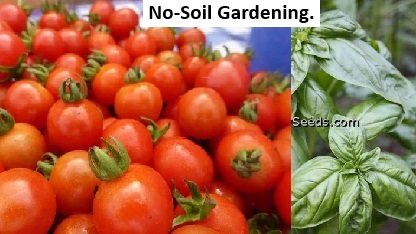| Welcome to the Inside Farm. Survival Plus, Prepping and Much More. |
|||||||||||
| No-Soil Gardening. Vegetable, Fruit and Herb Gardening Guide. |
|||||||||||
| By Howard M. Resh
What started years ago in laboratories is today a system of crop production used around the world. It is also a way for home gardeners to produce high-quality fresh vegetables, herbs, and ornamental plants efficiently year-round. Even though commercial and homemade systems are simple and reliable, hydroponic gardening retains its laboratory aura. Hydroponics began when scientists isolated and studied the six requirements for plant growth: temperature, light, water, oxygen, carbon dioxide, and mineral nutrients. Their goal was to determine the optimum amounts of each of these factors for a specific plant–an impossibility in soil outdoors. The surprise came when the scientists got all the growth requirements just right. Gardeners who witnessed the astounding growth under these conditions were early converts to hydroponic gardening. Other advantages include no heavy soil to dig, no weeds to pull, and no soil pests and diseases to overcome. Now in winter, with fresh vegetable prices rising and quality falling, is a good time to start growing your own crops indoors. Types of Hydroponic Gardens While the basic principles of all hydroponic gardens are the same, three basic systems have proven practical for home gardeners. In each case, plants grow in a sterile medium, instead of soil, and a small pump cycles a nutrient solution over roots. Nutrient film technique (NFT) gardens are easy to build at home and are well suited to a variety of vegetables and herbs. They work by constantly passing a thin stream of nutrient solution past roots. Plants grow in specially designed channels such as gutters or PVC pipes. Ebb-and-flow gardens are best for growing anything potted, such as house plants. A watertight tank or tub periodically fills, then drains back into the nutrient reservoir. Drip gardens deliver a nutrient solution to plant roots using the same types of emitters as in outdoor drip-irrigation systems. Draining nutrient solution can be trapped and recycled, or allowed to drain away. Growing Media Instead of soil for root growth, hydroponically grown plants need a porous but stable and inert material. Different materials can work, depending on the situation. Washed, 20-grit sand, various gravels, redwood bark, polyurethane foam, coconut fiber, perlite, and vermiculite will serve. But the two you’re most likely to encounter and use are rock wool and some type of expanded clay. Rock wool is manufactured by melting rock and extruding it into fine threads that are then pressed into loosely woven sheets. These sheets are cut into cubes, blocks, and slabs. Chief advantages are its ability to hold water and still provide excellent air circulation around roots. It is also very easy to work with. Compared to other materials, it costs somewhat more. Expanded clay is manufactured by heating various kinds of clays in kilns. The clays expand rather like popcorn. All provide excellent air circulation and don’t break down quickly. They are most often used for potted plants in an ebb-and-flow system and are available under various brand names. Light For most hydroponic gardens, high-intensity discharge (HID) lamps provide the most effective and efficient supplemental lighting. The two main types of lamps are high-pressure sodium and metal halide. These lights produce much more light per watt of electricity than fluorescent tubes, so the bulb can be several feet above the plants and still deliver sufficient light to the lower leaves. Both types of lamps use large, long-lived, and relatively expensive bulbs filled with various combinations of rare gases; the ballast is separate and plugs into a wall socket. Most gardeners prefer metal halide lamps because their light is both good for healthy growth and flowering, and pleasing to work around. Sodium lamps are more efficient and are preferred for some flowering plants, but the lamps’ reddish light is less comfortable to work around. Water and Nutrients Before transplanting into the hydroponic system, prepare the nutrient solution. While you can make up a solution from basic fertilizers, I recommend a ready-mixed formulation. This will simplify matters considerably, since you don’t need to buy several different kinds of fertilizer or accurate weighing equipment. While leafy vegetables require a different nutrient formulation from that used on tomatoes or cucumbers, you can use a general tomato formula if you are growing tomatoes with other vegetables. Hydroponic stores offer a wide range of formulations for various crops and even for different stages of growth. The nutrient solution must be kept in balance, meaning that the ratio of nutrients must be constant. As the plants grow, they will take up the elements at differing rates, causing the solution to become out of balance. For this reason, it is best simply to change the solution every two weeks. Use the old solution to feed indoor and outdoor plants. Besides keeping the nutrient ratios in balance, you also need to monitor the solution’s pH and the amount of dissolved salts (the electrical conductivity or EC). Maintain pH between 5.9 and 6.3, and EC between 1.6 and 2.5 (EC will depend in part upon the nutrient formulation). Dealers offer a variety of products to measure and adjust pH and EC. Add water regularly to the tank: plants consume water faster than nutrients. Keep the reservoir full most of the time, but you can allow it to fall three to four days before time to change it. Starting Plants The best way to start seedlings is to sow seed in rock wool cubes or blocks, available at garden centers or hydroponic retail stores. Soak the cubes in water for 24 hours before sowing seeds to adjust the pH and thoroughly moisten the cubes. Buy seeds of varieties known to grow well hydroponically. Examples are ‘Cobra’, ‘Boa’, ‘Caruso’, ‘Match’ and ‘Trust’ tomato; ‘Britania’, ‘Corona’, ‘Carmen’, ‘Futura’, ‘Marillo’ ‘Mustang’, and ‘Niagara’ cucumber; ‘Delphin’, ‘Goldstar’, ‘Luteus’, ‘Samantha’, ‘Tango’, and ‘Wonder’ pepper; and ‘Deci-Minor’, ‘Ibis’, ‘Impulse’, ‘Ostinata’, and ‘Yvonne’ lettuce. Seeds are available from hydroponic retail stores as well as many mail-order seed companies. Plant tomato and pepper seeds in 1-inch cubes, then transplant them later into 3-inch blocks. Sow lettuce seeds into 1-inch cubes and don’t transplant them into blocks. Sow cucumber seeds directly into 3-inch blocks. In each cube or block, sow two or three seeds for most vegetables, four or five herb seeds, and one cucumber seed (cucumbers germinate very well, and seed is expensive). Thin (with scissors) tomatoes, peppers, and lettuce to one plant per cube once the first true leaves begin to form. After sowing, water the cubes and cover them with polyethylene to keep in moisture; check daily and remove the cover as soon as germination occurs. Immediately upon germination, place the seedlings under light. Transplanting. Transplant lettuce when the first set of true leaves appears, 10 to 14 days after sowing. Transplant herbs at a similar stage, but note that the time until true leaves appear may be considerably longer. European cucumbers take two to three weeks, and peppers take five to six weeks. Transplant tomatoes into 3-inch rock wool cubes after the first true leaves unfold, in about two weeks. When two pairs of true leaves have formed (three to four weeks after sowing), transplant them to the growing system. When transplanting, be careful not to damage the tender roots underneath the blocks or cubes as you set them into the holes in the growing channels. Have the solution circulating before you set in the plants; that way, the blocks will immediately receive nutrient solution. Plant Care and Training The easiest way to support vine crops like cucumbers and tomatoes is to tie their stems to polyethylene string running from a support bar attached to ceiling hooks or from a support frame. Place hinged plastic stem clips under a strong leaf stem every foot or so along the plant’s main stem. The clamp’s hinge pinches the string when the clamp is closed. For additional support, wind the string around the main stem of the plant–one or two wraps between each set of clips. Train tomatoes and cucumbers to single stems and peppers to two stems. On tomatoes, pinch out all side shoots at leaf axils when they are about an inch long. Remove all suckers and tendrils from cucumbers. Also remove all fruit for the first 3 to 4 feet (using a step stool if necessary) then allow every other fruit to grow up to the support bar. Cut the top of the plant there allowing two side shoots to grow over the support bar and two-thirds of the way back down the main stem before pinching their growing tips. Allow all fruit to grow on these two stems. After they have produced fruit, cut them back to the second side shoot near the overhead support, and these will start growing again. Tomato flowers must be hand-pollinated. Vibrate the flowers for several seconds with your finger or a soft brush. Once fruits set, remove all but five per cluster to obtain uniform production and ripening. Tomatoes need about three months from seeding to first harvest, cucumbers about two months. The plants will grow for up to a year but become less productive with age and therefore should be replanted after six months. Each plant within this period can yield 20 pounds or more of fruit, while cucumbers should produce two or three fruits per week during their harvesting period. Peppers take longer to mature and produce fewer fruit than tomatoes. Butterhead-type lettuce such as ‘Bibb’ is ready to harvest 35 to 40 days from transplanting, about the same time as for leaf lettuces. You can also cut them at less than half that age to use with herbs and small-leaved vegetables in a mesclun mix. Harvest herbs regularly as soon as they have enough leaves that their growth won’t be set back by picking. Pinch off any flowers that form on mint or basil to keep the plants vegetative. Prune back any woody stems that develop, especially on basil. Where to Find Supplies If you don’t find a hydroponics store in your area, check with one of these mail-order sources: Agro Dynamics, 1430 N. Ventura Ave., Ventura, CA 93001; (888) 444-2476 American Hydroponics, Inc., 286 South G St., Arcata, CA 95521; (800) 458-6543, www.amhydro.com CropKing, Inc., 5050 Greenwich Rd., Seville, OH 44273; (800) 321-5211, www.cropking.com General Hydroponics, P.O. Box 1576, Sebastopol, CA 95472; (707) 824-9376, www.generalhydroponics.com Hydroasis, 7961 Melrose Ave., Los Angeles, CA 90046; (888) 355-4769, www.hydroasis.com Hydro Farm, 1455 E. Francisco Blvd., San Rafael, CA 94901; (800) 634-9999, www.hydrofarm.com Interior Gardens, Inc., 1620 Central Ave. NE, Suite 104, Minneapolis, MN 55413; (800) 738-4318, www.interiorgardens.com Sea of Green Hydroponics, 1828 E. University Dr., Suite 3, Tempe, AZ 85281; (602) 967-2045, www.sea-of-green.com Growing vegetables, fruits and herbs is easy! Whether you’re growing basil, blueberries, or tomatoes, our Food Gardening Guide will give you all the information you need to succeed.
|
|||||||||||
| 🌻 Bypass censorship by sharing one of these links: https://insidefarmer.com/the-farm-07/ or https://box91.com/the-farm-07/ or https://box127.com/the-farm-07/ or https://box145.com/the-farm-07/ or https://box154.com/the-farm-07/ or https://1realnews.com/the-farm-07 |
|||||||||||



















